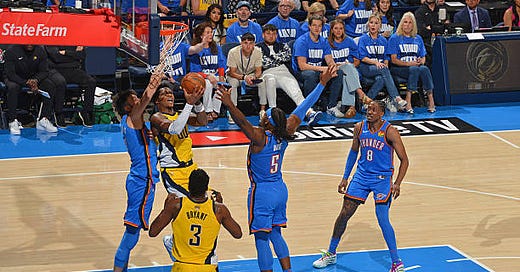How OKC Shut Down Indiana’s Fast Break
The Thunder’s transition defense turned a high-octane offense into a half-court grind — and it might decide the Finals.
The Pacers’ fast break has been unstoppable this postseason:
30 points per game in transition vs. the Knicks
22 vs. Cleveland
24 vs. Milwaukee
But against OKC? Just 14 and 13 points in Games 1 and 2.
OKC’s transition defense is a masterclass in team principles, consistent hustle, and collective effort. Let’s break down how they’ve turned one of the most explosive offenses into a half-court grind.
1️⃣ Getting Back on the Shot
OKC’s defenders get back immediately on the shot release. No ball-watching. No hesitation. It’s a clinic in floor balance and communication — and it limits Indiana’s chance to leak out and run.
2️⃣ Jamming Indiana’s QBs
Instead of letting Haliburton and McConnell get easy catches, OKC’s perimeter defenders jam the outlets whenever possible — forcing them go back to the ball and prevent those quick breakouts and advance passes. That slight delay disrupts Indiana’s pace and rhythm.
3️⃣ Team Transition Principles
The Thunder’s defensive principles shine here:
Fill the strong side first
Let trailing defenders rotate to the weak side
Build a wall before the paint - especially when a defender is behind the play already
Communicate and match up
This forces Indiana to play in the half court, exactly where OKC wants them.
4️⃣ Using the Numbers Game
The best teams know the defense can have a numbers advantage in transition if they get back. OKC uses that to:
Send extra help at the ball
Trap advanced passes
Force Indiana to reset their offense
That’s team defense at its best.
Wrap-Up:
OKC’s transition defense isn’t fancy — it’s consistent. They get back, jam the ball, rotate smart, and communicate early. That’s how you turn a high-octane offense into a half-court grind.
I’ll be breaking down OKC’s baseline-out-of-bounds defense next on Substack — stay tuned!



